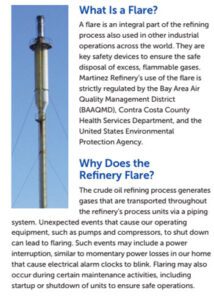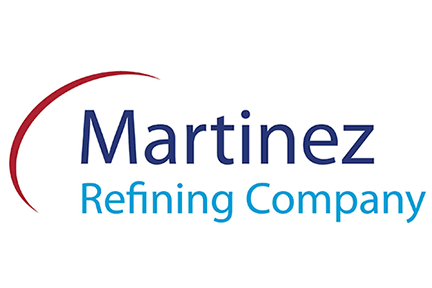- Planned Flaring: 1/3 through 1/8: Visible to 680 Freeway and Marina Vista Ave.
- Potential Intermittent Flaring:
- 1/3 through 1/20: Visible from 680 Freeway and Marina Vista Ave.
- 1/3 through 2/5: Visible from Pacheco Boulevard
We plan to issue public notifications via our Facebook page 24 hours in advance of scheduled flaring. Notifications will be provided to the City of Martinez and regulatory agencies. Please refer to the attached MRC Fact Sheet on Flaring for additional information on Flare Safety Systems.
Residents and businesses can register to receive Community Warning System alerts via text, email, or phone at https://cwsalerts.com/.
We remain committed to safe, reliable, and environmentally responsible operations, and we are committed to minimizing flaring in our operations. If you have questions, please call our Weekday Phone Number at (925) 313-3777 or our After-Hours Phone Number at (925) 313-3601
Understanding Flares (Fact Sheet)

Martinez Refining Company
The use of the flare system is an integral part of the refining process. It keeps the refinery running safely during unplanned operational interruptions or scheduled maintenance activities.
What Is a Flare?
A flare is an integral part of the refining process also used in other industrial operations across the world. They are key safety devices to ensure the safe disposal of excess, flammable gases. Martinez Refinery’s use of the flare is strictly regulated by the Bay Area Air Quality Management District (BAAQMD), Contra Costa County Health Services Department, and the United States Environmental Protection Agency.
Why Does the Refinery Flare?
The crude oil refining process generates gases that are transported throughout the refinery’s process units via a piping system. Unexpected events that cause our operating equipment, such as pumps and compressors, to shut down can lead to flaring. Such events may include a power interruption, similar to momentary power losses in our home that cause electrical alarm clocks to blink. Flaring may also occur during certain maintenance activities, including startup or shutdown of units to ensure safe operations.
How Do the Flares Work?
When operations are interrupted by an unplanned event or a planned maintenance activity, the refinery experiences a build-up of gases in its pipelines that results in an increased pressure in the lines. The pressure must be safely relieved through approved safety devices that are connected into the flare system. The flare prevents releasing unprocessed, flammable material directly into the environment. The excess gases are combined with steam and burned to produce water vapor and carbon dioxide. This system ensures maximum combustion of hydrocarbons while minimizing emissions into the air. A pilot light at the top of each flare burns continuously so the flare is always ready when needed.
Are the Flares Safe?
Yes. Although flaring is necessary and an environmentally and technically sound safety measure, our refinery tries to minimize its use.
What Is the Black Smoke?
Black smoke from the flare can occur when an insufficient amount of steam is available to help burn the hydrocarbons sent to the flare. Refinery personnel constantly watch the flare system via television monitors. If needed, they can adjust the steam flowing to the flare. In the rare instance of a sudden release of hydrocarbons to the system, there may be a delay in response before sufficient steam can be supplied to the burning process, and black smoke may be emitted.
What Is the Rumbling Noise?
Occasionally, during flare activity, a rumbling sound much like far-off thunder, resonates from the system. The rumbling that may be heard is the result of the turbulent mixing of vapors, air and steam during the flaring process.
Regulating Emissions
The BAAQMD strictly regulates emissions from the stacks and limits the density and duration of allowable smoke. Over time, the Martinez Refinery has taken a number of steps to recover and reprocess excess materials to lessen the flaring. However, when necessary, use of the flare system is still essential to the safe operation of the refinery.
Our Commitment
We are committed to safe, reliable and environmentally responsible operations, and we are committed to minimizing flaring in our operations.
REMEMBER—when you see the flares burning, be assured that their role is to keep the refinery operating safely.
Previous Stories:
- Dec. 23: Martinez Refining Company Statement on Thursday Flaring
- Dec. 19: Martinez Announces Town Hall Meeting to Discuss Martinez Refining Company Incidents
- Dec. 14: Contra Costa Health Recommends an Independent Investigation of Martinez Refinery Release
- Dec. 9: Flaring Friday Night at the Martinez Refining Company


1 comment
[…] Dec 31: Martinez Refining Company Says Maintenance Work Could Result in Flaring […]
Comments are closed.